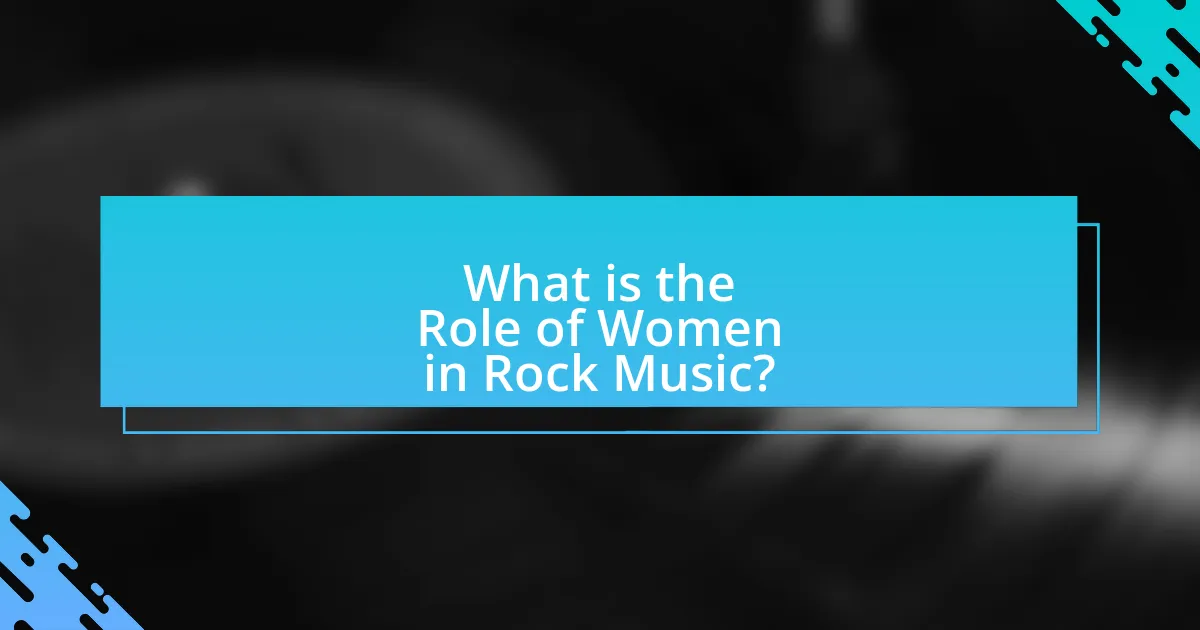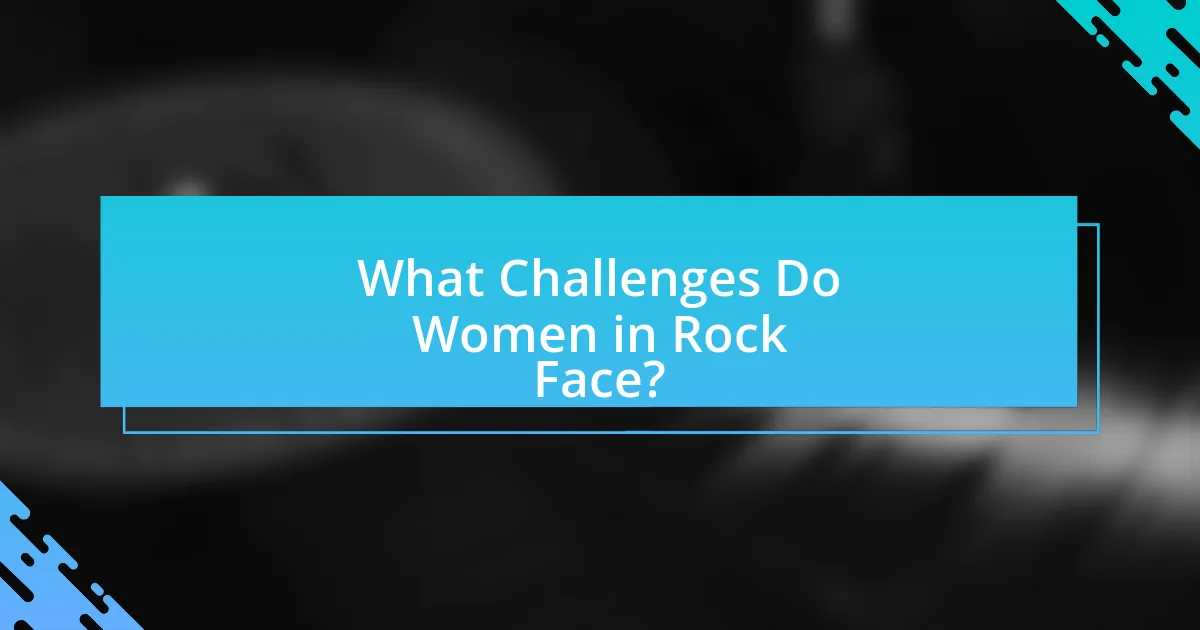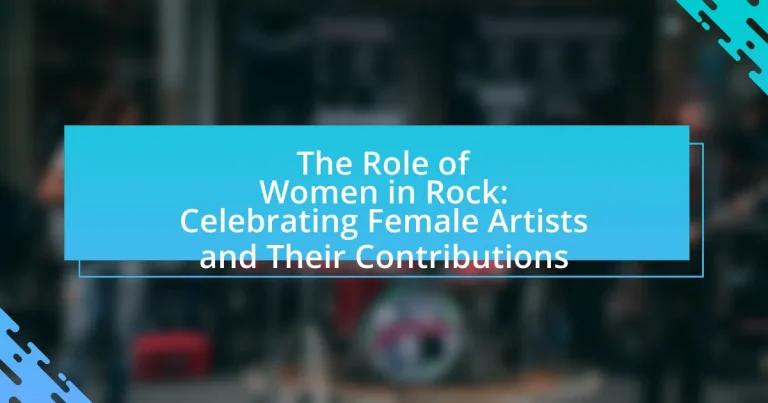The article focuses on the significant role of women in rock music, highlighting their contributions to the genre’s evolution, diversity, and cultural impact. It discusses pioneering female artists such as Janis Joplin, Joan Jett, and Debbie Harry, who have challenged gender norms and paved the way for future generations. Key milestones, societal influences, and the ongoing challenges faced by women in the industry are examined, alongside the importance of celebrating female artists to promote gender equality. The article also addresses contemporary female rock musicians and the initiatives aimed at increasing their visibility and representation in the music industry.

What is the Role of Women in Rock Music?
Women play a crucial role in rock music by contributing significantly to its evolution, diversity, and cultural impact. Female artists such as Janis Joplin, Joan Jett, and Stevie Nicks have not only shaped the sound of rock but have also challenged gender norms within the industry. Historically, women have been instrumental in various rock subgenres, from punk to alternative, with artists like Debbie Harry and Courtney Love pushing boundaries and inspiring future generations. According to a study by the USC Annenberg Inclusion Initiative, women comprised only 21.7% of artists in popular music from 2012 to 2019, highlighting the ongoing need for greater representation. This underrepresentation underscores the importance of recognizing and celebrating the contributions of women in rock music, as their influence continues to resonate across generations.
How have female artists shaped the rock genre?
Female artists have significantly shaped the rock genre by introducing diverse perspectives, innovative sounds, and challenging societal norms. Pioneers like Janis Joplin and Joan Jett broke barriers in the 1960s and 1970s, paving the way for future generations by asserting their presence in a male-dominated industry. Their influence is evident in the rise of female-led bands such as The Runaways and Heart, which showcased women’s capabilities as both musicians and songwriters. Additionally, artists like Alanis Morissette and Fiona Apple in the 1990s brought emotional depth and authenticity to rock music, further expanding its thematic range. The Rock and Roll Hall of Fame recognizes the contributions of female artists, with inductees like Aretha Franklin and Stevie Nicks highlighting their impact on the genre’s evolution. Overall, female artists have not only enriched rock music but have also played a crucial role in its cultural and social discourse.
What are some key milestones achieved by women in rock music?
Key milestones achieved by women in rock music include the induction of influential female artists into the Rock and Roll Hall of Fame, such as Janis Joplin in 1995 and Joan Jett in 2015, which recognized their significant contributions to the genre. Additionally, the emergence of all-female bands like The Runaways in the 1970s paved the way for future generations, while artists like Pat Benatar and Debbie Harry broke barriers in the 1980s, achieving commercial success and critical acclaim. Furthermore, the Grammy Awards have increasingly acknowledged female rock artists, with women winning major categories, such as the Best Rock Album award, highlighting their impact on the music industry.
How have societal changes influenced women’s roles in rock?
Societal changes have significantly influenced women’s roles in rock by promoting greater gender equality and challenging traditional gender norms. The feminist movements of the 1960s and 1970s, for instance, encouraged women to assert their identities and pursue careers in music, leading to the emergence of iconic female rock artists like Janis Joplin and Joan Jett. Additionally, the rise of the LGBTQ+ rights movement has fostered a more inclusive environment, allowing diverse expressions of identity within rock music. This shift is evidenced by the increasing visibility of female musicians in mainstream media and their participation in major music festivals, which were historically male-dominated. As a result, women have not only become prominent performers but also influential songwriters and producers, reshaping the landscape of rock music.
Why is it important to celebrate female artists in rock?
Celebrating female artists in rock is important because it acknowledges their significant contributions to the genre and promotes gender equality within the music industry. Historically, women have played crucial roles in shaping rock music, with artists like Joan Jett, Stevie Nicks, and Janis Joplin breaking barriers and influencing countless musicians. Recognizing their achievements not only highlights the diversity of talent in rock but also inspires future generations of female musicians to pursue their passions in a traditionally male-dominated field. Furthermore, studies show that increased visibility of female artists can lead to greater representation and opportunities for women in all areas of music, fostering a more inclusive environment.
What impact do female rock artists have on future generations?
Female rock artists significantly influence future generations by serving as role models and breaking gender barriers in the music industry. Their presence encourages young women to pursue careers in music, fostering a more inclusive environment. For instance, artists like Joan Jett and Patti Smith have inspired countless female musicians to embrace their creativity and assert their identities. Research indicates that female representation in music leads to increased participation of women in related fields, as seen in the rise of female-led bands and solo acts since the 1970s. This trend not only diversifies the rock genre but also empowers future generations to challenge societal norms and express themselves authentically.
How does recognition of female artists challenge gender stereotypes in music?
Recognition of female artists challenges gender stereotypes in music by showcasing their diverse talents and contributions, thereby redefining traditional notions of gender roles within the industry. For instance, artists like Joan Jett and Stevie Nicks have not only achieved commercial success but have also become cultural icons, demonstrating that women can excel in genres historically dominated by men. This visibility disrupts the stereotype that women are less capable or less serious musicians, as evidenced by the increasing number of female-led bands and solo acts achieving critical acclaim and commercial success, such as Haim and Billie Eilish. Furthermore, studies indicate that female representation in music can lead to greater acceptance of women in leadership roles across various sectors, reinforcing the idea that gender should not dictate artistic ability or career potential.

Who are the Pioneering Women in Rock?
Pioneering women in rock include artists such as Joan Jett, Janis Joplin, and Debbie Harry. Joan Jett, known for her work with The Runaways and her solo career, is often credited with breaking gender barriers in rock music during the 1970s and 1980s. Janis Joplin, a key figure in the late 1960s, was one of the first female rock stars to gain widespread acclaim, known for her powerful voice and emotive performances. Debbie Harry, as the lead singer of Blondie, helped to shape the punk and new wave movements in the late 1970s and early 1980s, showcasing the versatility and impact of women in rock music. These artists not only influenced their contemporaries but also paved the way for future generations of female musicians.
What contributions did early female rock artists make?
Early female rock artists significantly shaped the genre by breaking gender barriers and influencing musical styles. Artists like Joan Jett, Janis Joplin, and Debbie Harry not only showcased their vocal and instrumental talents but also challenged societal norms regarding women’s roles in music. For instance, Joan Jett’s band, The Runaways, was one of the first all-female rock bands to gain mainstream success, paving the way for future female musicians. Janis Joplin’s powerful performances and unique vocal style helped define the sound of rock in the late 1960s, while Debbie Harry’s presence in Blondie blended punk and pop, demonstrating the versatility of female artists in rock. These contributions laid the groundwork for the acceptance and celebration of women in a predominantly male-dominated industry.
Who are some of the most influential female rock musicians from the 1960s and 1970s?
Some of the most influential female rock musicians from the 1960s and 1970s include Janis Joplin, Joan Jett, and Grace Slick. Janis Joplin, known for her powerful voice and emotional performances, became a symbol of the counterculture movement and was a key figure in the psychedelic rock scene. Joan Jett, who gained fame with her band The Runaways and later as a solo artist, is recognized for her contributions to punk rock and her anthem “I Love Rock ‘n’ Roll.” Grace Slick, the lead singer of Jefferson Airplane, was notable for her role in the San Francisco music scene and her contributions to the development of rock music during the era. These artists not only shaped the sound of rock music but also paved the way for future generations of female musicians.
How did these artists pave the way for future generations?
Female artists in rock paved the way for future generations by breaking gender barriers and establishing a presence in a male-dominated industry. Artists like Joan Jett and Patti Smith challenged societal norms, demonstrating that women could be powerful, influential figures in rock music. Their success inspired subsequent generations of female musicians to pursue careers in rock, leading to a more diverse and inclusive music scene. For instance, the rise of artists such as Alanis Morissette and Courtney Love in the 1990s can be traced back to the groundwork laid by these pioneering women, who proved that female voices could resonate with audiences and achieve commercial success.
Which contemporary female rock artists are making waves today?
Contemporary female rock artists making waves today include Halsey, Phoebe Bridgers, and Brandi Carlile. Halsey has gained recognition for her genre-blending style and powerful lyrics, with her album “If I Can’t Have Love, I Want Power” debuting at number one on the Billboard 200 chart in 2021. Phoebe Bridgers has been acclaimed for her introspective songwriting and has received multiple Grammy nominations, including Best New Artist in 2021. Brandi Carlile, known for her vocal prowess and storytelling, won the Grammy Award for Best Americana Album in 2022 for “In These Silent Days.” These artists exemplify the significant impact women continue to have in the rock genre today.
What are the defining characteristics of their music?
The defining characteristics of female artists’ music in rock include strong lyrical themes, diverse musical styles, and a focus on empowerment. Female rock musicians often address social issues, personal experiences, and gender equality in their lyrics, which resonate with a wide audience. For example, artists like Joan Jett and Alanis Morissette have used their music to challenge societal norms and express individuality. Additionally, the incorporation of various genres, such as punk, grunge, and pop, showcases their versatility and innovation within the rock genre. This blend of lyrical depth and musical diversity has significantly shaped the landscape of rock music, highlighting the essential contributions of women in the industry.
How do these artists address current social issues through their work?
Female rock artists address current social issues through their work by using their music and public platforms to highlight themes such as gender equality, mental health, and social justice. For instance, artists like Billie Eilish and Halsey openly discuss mental health struggles and advocate for awareness, reflecting the growing societal focus on mental health issues. Additionally, musicians like Lizzo promote body positivity and self-acceptance, challenging societal beauty standards. These artists often incorporate their personal experiences into their lyrics, creating relatable narratives that resonate with audiences and spark conversations about these pressing social issues.

What Challenges Do Women in Rock Face?
Women in rock face significant challenges, including gender discrimination, underrepresentation, and societal stereotypes. Gender discrimination manifests in various forms, such as unequal pay compared to male counterparts; a study by the USC Annenberg Inclusion Initiative found that only 22.4% of artists in popular music are women. Underrepresentation in key industry roles, such as producers and sound engineers, further limits women’s influence and visibility in the genre. Societal stereotypes often pigeonhole female musicians into specific roles, undermining their artistic credibility and leading to a lack of support for their creative endeavors. These challenges collectively hinder the progress and recognition of women in the rock music scene.
What barriers have historically hindered women in the rock industry?
Historically, women in the rock industry have faced barriers such as gender discrimination, lack of representation, and societal stereotypes. Gender discrimination has manifested in limited access to opportunities, with women often being overlooked for roles in bands, production, and management. The lack of representation is evident in the underrepresentation of female artists in major music festivals and radio playlists, which has perpetuated the notion that rock music is predominantly a male domain. Societal stereotypes have also played a significant role, as women have been frequently pigeonholed into specific genres or roles, undermining their artistic contributions and capabilities. These barriers have collectively hindered the recognition and success of women in the rock industry.
How do gender biases manifest in the music industry today?
Gender biases in the music industry today manifest through unequal representation, pay disparities, and stereotypical expectations. For instance, women make up only about 21% of artists on popular music charts, indicating significant underrepresentation. Additionally, a study by the Annenberg Inclusion Initiative found that female artists earn less than their male counterparts, with women receiving only 30% of the total revenue from music sales. Furthermore, female musicians often face pressure to conform to traditional gender roles, which can limit their creative expression and opportunities for collaboration. These biases not only affect the visibility of female artists but also influence the overall dynamics within the industry.
What steps are being taken to overcome these challenges?
Efforts to overcome challenges faced by women in rock music include initiatives aimed at increasing visibility and representation. Organizations such as She Rocks Awards and Girls Rock Camp provide platforms for female artists, fostering mentorship and networking opportunities. Additionally, music festivals are increasingly featuring female-led acts, promoting gender diversity on stage. Research indicates that festivals with diverse lineups attract larger audiences, demonstrating the economic benefits of inclusivity. These steps collectively aim to dismantle barriers and create a more equitable environment for women in the rock genre.
How can the music industry support female artists more effectively?
The music industry can support female artists more effectively by implementing equitable funding and promotional strategies. Research indicates that female artists receive significantly less investment compared to their male counterparts; for instance, a 2021 report by the Annenberg Inclusion Initiative found that only 22.4% of artists on the Billboard Hot 100 were women. By prioritizing funding for female-led projects and ensuring equal representation in marketing campaigns, the industry can create a more balanced platform for female talent. Additionally, mentorship programs that connect established female artists with emerging ones can foster growth and provide essential guidance, further enhancing the visibility and success of women in music.
What initiatives exist to promote gender equality in rock music?
Initiatives promoting gender equality in rock music include organizations like She Rocks Awards, which honors female musicians and industry professionals, and the Women’s International Music Network, which provides networking opportunities and resources for women in the music industry. Additionally, festivals such as Girls Rock Camp empower young girls through music education and performance, fostering a supportive environment for female artists. Research indicates that these initiatives have led to increased visibility and opportunities for women in rock, contributing to a more balanced representation in the genre.
How can audiences contribute to the success of female rock artists?
Audiences can contribute to the success of female rock artists by actively supporting their music through attendance at concerts, purchasing albums, and engaging with their content on social media. This support translates into increased visibility and financial success, which is crucial in an industry where female artists often face barriers. For instance, a study by the Annenberg Inclusion Initiative found that female artists receive significantly less airplay and media coverage compared to their male counterparts, highlighting the importance of audience engagement in leveling the playing field. By promoting female rock artists and advocating for their work, audiences can help create a more equitable music landscape.
What are some practical ways to celebrate and support women in rock?
To celebrate and support women in rock, one practical way is to promote female artists through dedicated playlists and radio shows that highlight their music. This approach not only increases visibility but also encourages listeners to explore their work. Additionally, organizing events such as women-focused music festivals or concerts can provide a platform for female musicians to showcase their talent, as seen with events like the She Rocks Awards, which honor women in the music industry. Supporting female-led record labels and initiatives, such as Girls Rock Camps, which empower young girls through music education, further contributes to the growth and recognition of women in rock. These actions collectively foster an inclusive environment that celebrates and uplifts female artists in the rock genre.
How can fans engage with female rock artists and their music?
Fans can engage with female rock artists and their music by attending live performances, participating in social media interactions, and purchasing merchandise. Attending concerts allows fans to experience the music firsthand and connect with the artists directly. Social media platforms like Instagram and Twitter enable fans to follow their favorite artists, comment on posts, and share their thoughts, fostering a sense of community. Additionally, buying merchandise supports the artists financially and helps promote their work. According to a 2021 report by the Music Industry Association, live music events and merchandise sales are significant revenue sources for artists, highlighting the importance of fan engagement in sustaining their careers.
What resources are available for discovering new female rock talent?
Resources available for discovering new female rock talent include online platforms, music festivals, and dedicated music blogs. Websites like Bandcamp and SoundCloud allow emerging female rock artists to share their music directly with audiences. Music festivals such as Girls Rock Camp and She Rocks Fest specifically highlight female talent, providing exposure and networking opportunities. Additionally, blogs like The Alternative and She Shreds Magazine focus on promoting female musicians, offering reviews and interviews that can help listeners discover new artists. These resources collectively contribute to the visibility and recognition of female rock talent in the music industry.















